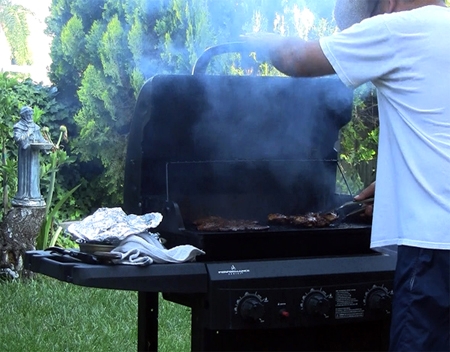"Temperatures are important factors in protecting your food. You want to be really careful that you keep hot food hot and cold food cold," stresses Patti Wooten-Swanson, UCCE nutrition, family, and consumer science advisor in San Diego County. Don't leave perishable food sitting out on the counter or the picnic table longer than necessary, she adds.
Food-borne illnesses peak in the summer months, mostly attributed to bacteria such as salmonella and E. coli when raw meats are not handled properly or not cooked to a high enough temperature, according to the Centers for Disease Control and Prevention.
"Food-borne illness, what we commonly call food poisoning, is a very severe problem in the United States," says Wooten-Swanson in a video podcast and news release to Spanish-speaking consumers about the risks associated with cooking and eating outdoors.
A screen shot of the Spanish-language video podcast featuring Patti Wooten-Swanson.
"We don't typically think about that but about 75 million people get food-borne illnesses every year, and some people die," she told ANR News and Information Outreach in Spanish.
The actual number of food poisonings may be much higher since most people mistake food-borne illness with common flu and digestive problems. The symptoms are very similar: upset stomach, diarrhea, vomiting or nausea. The most likely victims are small children, pregnant women, the elderly and anyone with an impaired immune system.
"So it's very important that we take very good care with the food that we are preparing and serving," says Wooten-Swanson.
That includes cut fresh fruit and vegetables, which can also develop deadly bacteria when left out for more than two hours without refrigeration and in less than an hour when the temperature rises above 90 degrees. That rule should also be observed with any food leftovers to prevent food contamination.
The CDCs estimate that about 325,000 people are hospitalized and 5,000 die in the U.S. due to food-borne illness every year. More than 1.4 million food poisonings and about 580 deaths per year are attributed to salmonella alone. Approximately 217,000 people get sick with E. coli contamination and the number of deaths is close to a hundred.
When barbecuing, Wooten-Swanson recommends keeping raw meats in the refrigerator or in a cooler - with plenty of ice – until the moment they are put on the grill. She suggests outdoors lovers and barbecue aficionados follow the basic recommendations issued by the U.S. Food and Drug Administration this time of the year.
She advises cooks not to rely on the exterior appearance of meats as they are cooked on the grill. Chicken, steak or a hamburger patty might look well done or even charred on the outside, but its innermost parts may be undercooked. In most cases, bacteria are killed by heat only when the cooking temperature has reached 165 F degrees. The only way to know for sure is with a meat thermometer, says the UC nutrition advisor.
Safe barbecue (Photo: A. Hauffen)